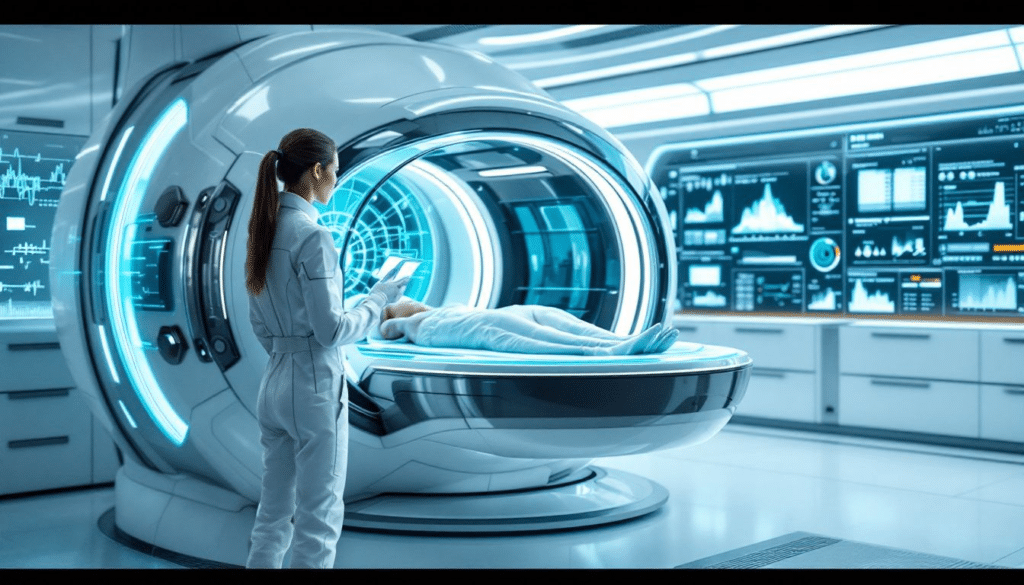Thinking about stem cell therapy? A stem cell therapist will assess your eligibility, offer a personalized treatment plan, and monitor your progress. This guide covers the role of a stem cell therapist, what to expect, and the associated benefits and risks.
Key Takeaways
Stem cell therapy utilizes stem cells to repair and regenerate damaged tissues, showing promise in treating various conditions, including blood-related cancers and degenerative joint diseases.
While offering significant benefits, stem cell therapy carries risks such as potential immune responses and tumor formation, necessitating thorough patient evaluations and ongoing monitoring by qualified therapists.
Choosing a qualified stem cell therapist and reputable clinic is crucial for ensuring safe and effective treatment; factors to consider include the therapist’s training, clinic accreditation, and available technology.
Stem Cell Therapist: Benefits, Risks, and What to Expect

Stem cell therapy is an innovative medical approach that uses stem cells to repair or regenerate damaged tissues and treat various conditions. These unique cells have the remarkable ability to differentiate into various cell types, such as muscle, bone, or nerve cells, making them a powerful tool in regenerative medicine. Adult stem cell therapy treatments can be delivered via intravenous injection, intrathecal administration, or localized injections, tailored to the specific condition and treatment plan.
One of the significant benefits of stem cell therapy is its potential to treat a wide range of conditions, from blood-related cancers to degenerative joint diseases. Umbilical cord-derived mesenchymal stem cells (MSCs) have shown promise in treating degenerative joint conditions and reconstructing bone and cartilage, largely due to their lower risk of immune rejection compared to other cell types. Furthermore, these cells can be harvested non-invasively, simplifying their acquisition.
Despite its potential, stem cell therapy comes with risks. Potential complications include immune responses and tumor formation. Therefore, it is crucial for patients to undergo thorough evaluations by qualified stem cell therapists to determine their suitability for treatment. Understanding both the benefits and risks allows patients to make informed decisions about their healthcare journey.
Introduction
Stem cell therapy is revolutionizing the way we approach medical treatment, offering hope for conditions that were once deemed untreatable. These unique cells, capable of self-renewal and differentiation into various cell types, play a critical role in tissue maintenance and repair within the human body. Stem cell therapy utilizes these properties to modulate immune responses and repair damaged tissues, presenting a promising avenue for regenerative medicine.
As research continues to expand the potential applications of stem cell therapy, it is essential to understand the benefits, risks, and processes involved. This overview offers insights into the current state of stem cell therapy, aiding potential patients in navigating this exciting field.
Whether considering treatment for yourself or a loved one, or simply curious about the latest medical advancements, this guide will equip you with essential knowledge.
Understanding Stem Cell Therapy
Stem cell therapy is a method that uses stem cells to promote the repair of diseased or injured tissues, offering a new approach to treating various medical conditions. These cells are unique in their ability to differentiate into multiple cell types, such as muscle, bone, or nerve cells, which makes them invaluable in regenerative medicine. The most common sources of stem cells include bone marrow, adipose tissue, and umbilical cord tissue.
Embryonic stem cells, sourced from early-stage embryos, possess the highest differentiation potential, making them a major research focus. However, their use raises ethical concerns due to the destruction of embryos. On the other hand, adult stem cells, found in tissues like bone marrow and fat, have a more limited differentiation potential but are less controversial and easier to obtain. Human stem cells, including human embryonic stem cells, along with mesenchymal stem cells (MSCs), stem cell derived multipotent stem cells, stand out for their ability to differentiate into bone, cartilage, and muscle cells, offering promising applications in orthopedic and reconstructive medicine.
Stem cell therapy can be delivered through various methods, including intravenous injection, intrathecal administration, or localized injections, depending on the condition being treated. The choice of delivery method is critical for ensuring the stem cells reach the target area and exert their therapeutic effects. This flexibility in administration enables tailored treatments to address a broad spectrum of medical needs.
Role of a Stem Cell Therapist

A stem cell therapist plays a crucial role in the successful administration of stem cell therapies. These professionals are responsible for evaluating patients to determine their suitability for treatment based on their medical history and current health status. This initial assessment is vital for identifying potential risks and ensuring that the therapy is appropriate for the patient’s condition.
Once a patient is deemed suitable for stem cell therapy, the therapist develops an individualized treatment plan tailored to the patient’s specific needs. This plan may involve various techniques for administering the therapy, such as injections or infusions, depending on the treatment protocol. The goal is to optimize the therapeutic outcomes while minimizing potential risks.
Another critical responsibility of a stem cell therapist is monitoring patients during and after treatment. This involves managing any immediate side effects or complications and ensuring that the patient responds well to the therapy. Continuous follow-up care is essential for tracking the long-term efficacy of the treatment and making any necessary adjustments to the patient’s care plan.
Types of Stem Cell Therapies Administered
Stem cell therapy encompasses a variety of treatments, each tailored to address specific medical conditions. One of the most established forms of stem cell treatment is the hematopoietic stem cell transplant (HSCT), used primarily to treat blood-related cancers such as leukemia, Hodgkin disease, and non-Hodgkin lymphoma. These transplants, also known as bone marrow transplants, involve replacing damaged or abnormal bone marrow stem cells with healthy ones from a donor or the patient themselves. Stem cell transplantation is a critical procedure in these treatments.
Another promising area of stem cell therapy is the use of mesenchymal stem cells (MSCs) for orthopedic and reconstructive treatments. For example, MSCs derived from bone marrow (BM-MSCs) can be administered by spraying onto burn sites or adding over a dermal matrix sheet to promote healing and tissue regeneration. Additionally, adipose-derived stem cells have been used in treatments for myocardial infarction, showing significant potential in cardiovascular medicine.
In cancer management, stem cell therapies include autologous and allogeneic HSCTs. Autologous HSCTs involve using the patient’s own stem cells, while allogeneic HSCTs use stem cells from a compatible donor. These therapies are critical for patients undergoing high-dose chemotherapy or radiotherapy, as they help restore the body’s ability to produce healthy blood cells.
The use of umbilical cord blood as a source of stem cells is another exciting development in the field. These cells are particularly valuable because they have a lower risk of immune rejection and are easier to obtain through non-invasive harvesting methods. This makes them an attractive option for treating various conditions, including blood-related disorders and degenerative diseases.
Finally, experimental therapies using embryonic stem cells and induced pluripotent stem cells (iPSCs) are being explored in clinical trials. These therapies hold promise for treating a wide range of conditions, from neurological disorders to diabetes, by harnessing the cells’ ability to differentiate into any cell type in the body. While still in the experimental stage, these therapies represent the cutting edge of regenerative medicine.
Conditions Treated by Stem Cell Therapists

Stem cell therapy has shown promise in treating a wide range of medical conditions, offering new hope for patients with previously untreatable diseases. One of the most well-established applications is in the treatment of blood-related cancers, such as leukemia and certain blood disorders. Hematopoietic stem cell transplants have been successfully used for decades to treat these conditions, providing patients with a chance for remission and recovery.
Beyond blood-related cancers, stem cell therapies are being investigated for their potential to treat chronic conditions such as type 1 diabetes, Parkinson’s disease, amyotrophic lateral sclerosis (ALS), and heart failure. In these cases, stem cells can potentially regenerate damaged tissues, offering a new approach to managing these debilitating diseases.
Orthopedic and reconstructive medicine is another area where stem cell therapy is making significant strides. Mesenchymal stem cell (MSC) therapies have shown potential in treating degenerative joint conditions, such as osteoarthritis, and in reconstructing bone and cartilage. These therapies can improve joint function and reduce pain, enhancing the quality of life for patients with these conditions.
Stem cell treatments are also being explored for their potential to regenerate tissue affected by chronic conditions and injuries. For example, therapies targeting spinal cord injuries and neurological disorders are progressing through various stages of research and clinical trials. These treatments aim to repair damaged nerve tissues and restore function, offering hope for patients with conditions that currently have limited treatment options.
The Process of Stem Cell Therapy
The process of stem cell therapy begins with a thorough health assessment to ensure the patient is fit for the procedure. This evaluation includes a detailed medical history, physical examination, and various diagnostic tests to determine the patient’s overall health and suitability for stem cell therapy. The purpose is to identify potential risks and customize the treatment plan to the patient’s needs.
Once the patient is deemed suitable, stem cells are sourced from blood, bone marrow, or cord blood, depending on the patient’s condition and availability. For instance, bone marrow-derived stem cells are commonly used in hematopoietic stem cell transplants, while umbilical cord blood is often used for its ease of collection and lower risk of immune rejection. The choice of stem cell source is crucial for the success of the therapy.
Before the actual transplant, patients typically undergo conditioning treatment, which involves high doses of chemotherapy and sometimes radiotherapy to prepare the body for the transplant. This step is essential for eliminating any remaining diseased cells and creating a conducive environment for the new stem cells to engraft and proliferate. The transplant itself is usually performed through a central line, a procedure that is not painful and is relatively straightforward.
Post-transplant care is critical for ensuring the success of stem cell therapy. Patients are closely monitored for any immediate side effects or complications, and regular follow-up visits are scheduled to track the long-term efficacy of the treatment. This ongoing care helps manage any potential risks and ensures that the patient is responding well to the therapy, ultimately leading to better health outcomes.
Training and Qualifications of a Stem Cell Therapist
Becoming a stem cell therapist requires comprehensive training that includes foundational knowledge of stem cell biology and its therapeutic applications. This training typically involves coursework in cell biology, regenerative medicine, and the specific techniques used in stem cell therapy. Understanding the science behind stem cells and their potential for treating various conditions is crucial for any aspiring stem cell therapist.
Hands-on training is an essential component of a stem cell therapist’s education. This practical experience covers patient evaluation, the administration of stem cell treatments, and post-treatment care. Healthcare providers from diverse backgrounds, including physicians, nurse practitioners, and other medical professionals, can undergo specific training programs to incorporate stem cell therapy into their practices. The hands-on component ensures that therapists are well-equipped to handle the complexities of stem cell treatments and provide the best possible care for their patients.
The experience and training of the medical team are critical factors that influence the success of stem cell therapy. Therapists must stay up-to-date with the latest advancements in the field, including new techniques, emerging research, and evolving regulatory guidelines. Continuous education and professional development are essential for maintaining high standards of care and ensuring that patients receive the most effective and safe treatments available.
Potential Benefits of Stem Cell Therapy

Before:
Stem cell therapy offers numerous potential benefits, particularly in the field of regenerative medicine. One of the most significant advantages is the ability of stem cells to generate healthy cells that can replace those damaged by illness or injury. This capability makes stem cell therapy a powerful tool for tissue regeneration and healing. For example, adipose tissue-derived mesenchymal stem cells (AT-MSCs) have shown promise in aiding tissue regeneration and accelerating the healing process.
After:
Stem cell therapy offers numerous potential benefits, particularly in the field of regenerative medicine. Here are some significant advantages:
The ability of stem cells to generate healthy cells that can replace those damaged by illness or injury.
A powerful tool for tissue regeneration and healing.
Adipose tissue-derived mesenchymal stem cells (AT-MSCs) have shown promise in aiding tissue regeneration and accelerating the healing process.
Another critical benefit of stem cell therapy is its potential to develop new tissues for transplant, addressing the shortage of donor organs. Growing tissues and organs in the lab using stem cells could provide a sustainable solution to the organ donor crisis. Such advancements have the potential to revolutionize transplantation and save countless lives.
Stem cells also play a vital role in improving blood supply to damaged areas, which can lead to faster recovery from injuries. For instance, the use of BM-MSCs in burn treatment has shown improved vascularization, reduced scarring, and enhanced wound recovery. These anti-inflammatory effects and the ability of stem cells to home to damaged tissues and support tissue remodeling further contribute to their therapeutic potential.
Stem cell therapy also serves as a platform to test new drugs for safety and effectiveness before human trials, potentially accelerating the development of new treatments. This application of stem cells helps researchers identify promising therapies more quickly and brings them to patients sooner.
Overall, the potential benefits of stem cell therapy are vast, offering new hope for patients with a wide range of medical conditions.
Risks and Ethical Considerations
While stem cell therapy holds great promise, it is not without its risks and ethical considerations. One of the primary ethical concerns involves the use of embryonic stem cells, which requires the destruction of human embryos. This practice has sparked significant debate and led to the development of strict guidelines and regulations governing embryonic stem cell research. The moral acceptability of using stem cells derived from embryos continues to be a contentious issue.
Another significant risk associated with stem cell therapy is the potential for uncontrolled differentiation of stem cells after transplantation, which can lead to tumor formation, specifically teratomas. This risk underscores the importance of thorough patient evaluation and careful monitoring during and after treatment. Additionally, mesenchymal stem cells (MSCs) have been associated with the potential to promote tumor growth and metastasis, further highlighting the need for caution.
The regulation of stem cell therapies varies significantly across different countries, reflecting diverse ethical perspectives and levels of oversight. Patients considering stem cell therapy must be aware of these variations and seek treatment from reputable clinics that adhere to high safety and quality standards.
By understanding the risks and ethical considerations, patients can make informed decisions about their treatment options and ensure they receive the best possible care.
Latest Research and Clinical Trials
The field of stem cell therapy is rapidly advancing, with numerous ongoing clinical trials aimed at improving our understanding and application of these therapies. These trials are exploring the safety and efficacy of mesenchymal stem cells (MSCs) in treating various conditions, including multiple sclerosis, congenital heart disease, and diabetic kidney disease. The results of these trials could significantly impact the future of regenerative medicine and expand the range of treatable conditions.
One notable development is the recent negotiations with the FDA to advance stem cell therapies to human trials. These regulatory actions are crucial for ensuring the safety and effectiveness of new treatments before they become widely available. For instance, an embryonic stem-cell-based therapy has been cleared for use in treating acute spinal cord injury, demonstrating the potential of these therapies to address severe and debilitating conditions.
As research continues to progress, new advancements in stem cell therapy hold the potential to transform treatment approaches and improve patient outcomes. Staying informed about the latest research and clinical trials is essential for patients and healthcare providers alike, as it enables them to make well-informed decisions and take advantage of cutting-edge therapies.
The future of stem cell therapy looks promising, with ongoing research paving the way for new and innovative treatments.
Choosing the Right Stem Cell Therapist

Selecting the right stem cell therapist is crucial for ensuring a safe and effective treatment experience. One of the first steps in choosing a therapist is to investigate their training and qualifications. Therapists should have extensive training in stem cell biology, therapeutic applications, and hands-on experience in administering stem cell treatments. Healthcare providers from various backgrounds, including physicians and nurse practitioners, can undergo specialized training to incorporate stem cell therapy into their practices.
Another important factor to consider is the accreditation of the clinic where the therapy will be administered. Reputable clinics should be recognized by reputable organizations and adhere to high safety and quality standards. This accreditation ensures that the clinic follows best practices and provides patients with the highest level of care.
Additionally, the clinic’s infrastructure, including advanced technology and cleanliness, is vital for safe and effective treatment. Patients should also consider the experience and training of the medical team, as these factors significantly influence the success of stem cell therapy.
A well-trained and experienced team is better equipped to handle the complexities of stem cell treatments and provide the best possible care. Evaluating these factors carefully enables patients to choose a qualified stem cell therapist, thereby increasing the chances of positive treatment outcomes.
Summary
Stem cell therapy represents a groundbreaking approach in the field of regenerative medicine, offering new hope for patients with a wide range of medical conditions. By harnessing the unique properties of stem cells, this therapy has the potential to repair and regenerate damaged tissues, improve patient outcomes, and address the shortage of donor organs. However, it is essential for patients to be aware of the potential risks and ethical considerations associated with stem cell therapy.
In summary, stem cell therapy holds immense promise, but it is crucial to choose the right therapist and understand the treatment process thoroughly. By staying informed about the latest research and clinical trials, patients can make well-informed decisions and take advantage of cutting-edge therapies. The future of stem cell therapy is bright, with ongoing advancements paving the way for new and innovative treatments that have the potential to transform healthcare.
Frequently Asked Questions
What is stem cell therapy?** **?
Stem cell therapy is a medical treatment that harnesses the unique properties of stem cells to facilitate the repair and regeneration of damaged or diseased tissues. This approach holds significant promise in the field of regenerative medicine.
What conditions can be treated with stem cell therapy?** **?
Stem cell therapy can effectively treat various conditions, including blood-related cancers (like leukemia), chronic illnesses (such as type 1 diabetes and Parkinson’s disease), and orthopedic issues (like degenerative joint conditions). Its potential applications are expanding across multiple medical fields.
What are the potential risks of stem cell therapy?** **?
The potential risks of stem cell therapy encompass immune responses, tumor formation, and ethical dilemmas related to embryonic stem cell use. It is crucial for patients to seek treatment from qualified professionals and undergo comprehensive evaluations to mitigate these risks.
How are stem cells sourced for therapy?** **?
Stem cells are sourced from various tissues, including blood, bone marrow, and cord blood, based on the specific needs of the patient. The selection of the appropriate source is essential for effective therapeutic outcomes.
How do I choose the right stem cell therapist?** **?
To choose the right stem cell therapist, prioritize their qualifications, the clinic’s accreditation, and the experience of the medical staff. These factors are crucial for ensuring a safe and successful treatment.


